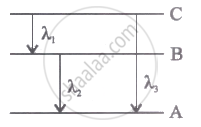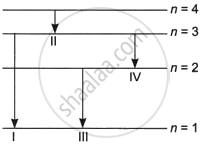Advertisements
Advertisements
Question
A 12.9 eV beam of electronic is used to bombard gaseous hydrogen at room temperature. Upto which energy level the hydrogen atoms would be excited ?
Calculate the wavelength of the first member of Paschen series and first member of Balmer series.
Solution
Energy of the electron in the nth state of an atom = \[- \frac{13 . 6 z^2}{n^2}\] eV
Here, z is the atomic number of the atom.
For hydrogen atom, z = 1
Energy required to excite an atom from initial state (ni) to final state (nf) = \[- \frac{13 . 6}{{n_f}^2} + \frac{13 . 6}{{n_i}^2}\]eV
This energy must be equal to or less than the energy of the incident electron beam.
∴ \[- \frac{13 . 6}{{n_f}^2} + \frac{13 . 6}{{n_i}^2}\] 12.9
Energy of the electron in the ground state = ∴ \[- \frac{13 . 6}{1^2} = - 13 . 6\] eV
\[\therefore - \frac{13 . 6}{{n_f}^2} + 13 . 6 = 12 . 9\]
\[13 . 6 - 12 . 9 = \frac{13 . 6}{{n_f}^2}\]
\[{n_f}^2 = \frac{13 . 6}{0 . 7} = 19 . 43\]
\[ \Rightarrow n_f = 4 . 4\]
State cannot be a fraction number.
∴ \[n_f\] =4
Hence, the hydrogen atom would be excited up to
Rydberg's formula for the spectrum of the hydrogen atom is given by:
Rydberg's constant, R = \[1 . 097 \times {10}^7\] m-1
For the first member of the Paschen series:
\[n_1 = 3 \]
\[ n_2 = 4\]
\[\frac{1}{\lambda} = 1 . 097 \times {10}^7 \left[ \frac{1}{3^2} - \frac{1}{4^2} \right]\]
\[\lambda = 18761\]Å
For the first member of Balmer series:
\[n_1 = 2 \]
\[ n_2 = 3\]
\[\frac{1}{\lambda} = 1 . 097 \times {10}^7 \left[ \frac{1}{2^2} - \frac{1}{3^2} \right]\]
\[\lambda = 6563\]Å
APPEARS IN
RELATED QUESTIONS
Given the ground state energy E0 = - 13.6 eV and Bohr radius a0 = 0.53 Å. Find out how the de Broglie wavelength associated with the electron orbiting in the ground state would change when it jumps into the first excited state.
The total energy of an electron in the first excited state of the hydrogen atom is about −3.4 eV.
What is the kinetic energy of the electron in this state?
The total energy of an electron in the first excited state of the hydrogen atom is about −3.4 eV.
Which of the answers above would change if the choice of the zero of potential energy is changed?
A Carnot engine absorbs 1000 J of heat energy from a reservoir at 127°C and rejects 600 J of heat energy during each cycle. The efficiency of the engine and temperature of the sink will be:
Energy of an electron at infinity from nucleus is ______.
Energy levels A, B, C of acertain atom corresponding to increasing value of energy, i.e., EA< E8 < Ee. If λ1, λ2 and λ3 are the wavelength of radiations corresponding to the transitions C to B, B to A and C to A respectively, which of the following statements is correct?

Two H atoms in the ground state collide inelastically. The maximum amount by which their combined kinetic energy is reduced is ______.
Radiation coming from transitions n = 2 to n = 1 of hydrogen atoms fall on He+ ions in n = 1 and n = 2 states. The possible transition of helium ions as they absorb energy from the radiation is ______.
Which of the following is true for X-rays?
The diagram shows the four energy levels of an electron in the Bohr model of the hydrogen atom. Identify the transition in which the emitted photon will have the highest energy.

